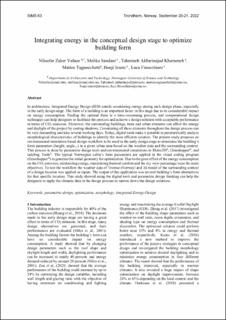| dc.contributor.author | Zaker Vafaee, Niloofar | |
| dc.contributor.author | Sandani, Melika | |
| dc.contributor.author | Khamene, Tahmineh Akbarinejad | |
| dc.contributor.author | Tagnocchetti, Matteo | |
| dc.contributor.author | Izumi, Bunji | |
| dc.contributor.author | Finocchiaro, Luca | |
| dc.date.accessioned | 2023-03-10T08:34:14Z | |
| dc.date.available | 2023-03-10T08:34:14Z | |
| dc.date.created | 2022-11-11T14:00:17Z | |
| dc.date.issued | 2022 | |
| dc.identifier.isbn | 978-91-7929-545-5 | |
| dc.identifier.uri | https://hdl.handle.net/11250/3057539 | |
| dc.description.abstract | In architecture, Integrated Energy Design (IED) entails considering energy during each design phase, especially in the early design stage. The form of a building is an important factor in this stage due to its considerable impact on energy consumption. Finding the optimal form is a time-consuming process, and computational design techniques can help designers to facilitate this process and achieve a design solution with acceptable performance in terms of CO2 emission. Moreover, the surrounding buildings, trees and urban elements can affect the energy and daylight of the project by casting shadows. Considering all these elements throughout the design process can be very demanding and take several working days. Today, digital tools make it possible to parametrically analyze morphological characteristics of buildings to identify the most efficient solution. The present study proposes an environmental-simulation based design workflow to be used in the early design stage to determine the building’s form parameters (height, angle,..) in a given urban area based on the weather data and the surrounding context. This process is done by parametric design tools and environmental simulations in Rhino3D®, Grasshopper®, and ladybug Tools®. The typical Norwegian cabin’s form parameters are applied in the visual coding program (Grasshopper®) to generate the initial geometry for optimization. Due to the great effect of the energy consumption on the CO2 emission, minimizing energy, maximizing thermal comfort and the sky view percentage were the main objectives. To test the workflow the weather data of Tromsø (Norway) and 3d model of the surrounding context of a design location was applied as inputs. The output of this application was several building’s form alternatives for that specific location. This study showed using the digital tools and parametric design thinking can help the designers to apply the climatic data in the design process to narrow down the design solutions. | en_US |
| dc.language.iso | eng | en_US |
| dc.publisher | Linköping University Electronic Press | en_US |
| dc.relation.ispartof | Proceedings of the 63rd International Conference of Scandinavian Simulation Society, SIMS 2022, Trondheim, Norway, September 20-21, 2022 | |
| dc.rights | Navngivelse 4.0 Internasjonal | * |
| dc.rights.uri | http://creativecommons.org/licenses/by/4.0/deed.no | * |
| dc.title | Integrating energy in the conceptual design stage to optimize building form | en_US |
| dc.title.alternative | Integrating energy in the conceptual design stage to optimize building form | en_US |
| dc.type | Chapter | en_US |
| dc.description.version | publishedVersion | en_US |
| dc.source.pagenumber | 318-324 | en_US |
| dc.identifier.doi | https://doi.org/10.3384/ecp192045 | |
| dc.identifier.cristin | 2072532 | |
| cristin.ispublished | true | |
| cristin.fulltext | original | |
| cristin.qualitycode | 1 | |

